engine FIAT 500 2020 Owner handbook (in English)
[x] Cancel search | Manufacturer: FIAT, Model Year: 2020, Model line: 500, Model: FIAT 500 2020Pages: 228, PDF Size: 6.01 MB
Page 73 of 228
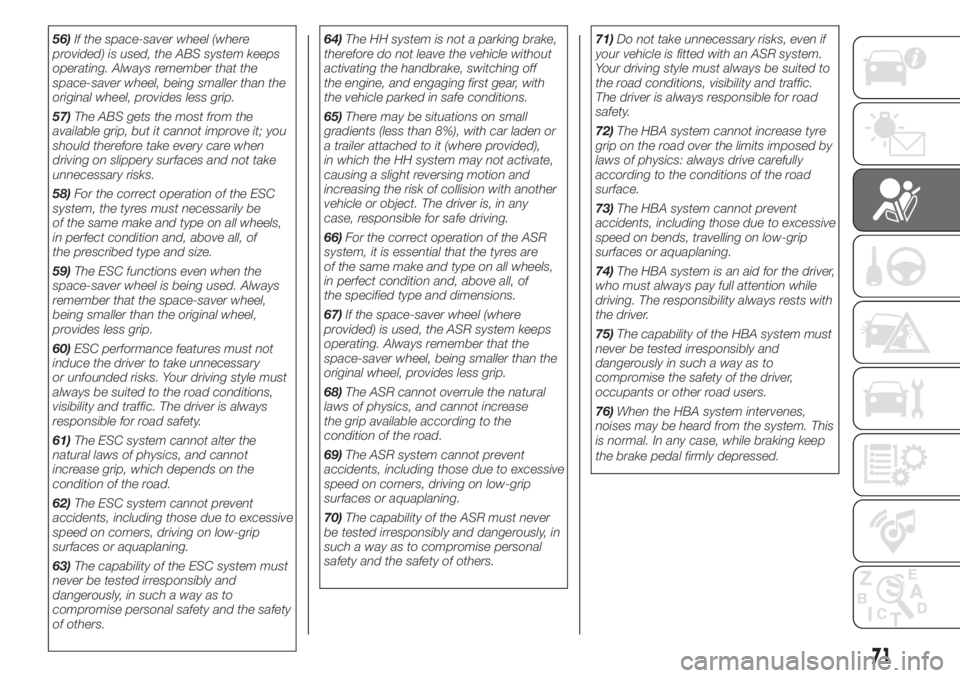
56)If the space-saver wheel (where
provided) is used, the ABS system keeps
operating. Always remember that the
space-saver wheel, being smaller than the
original wheel, provides less grip.
57)The ABS gets the most from the
available grip, but it cannot improve it; you
should therefore take every care when
driving on slippery surfaces and not take
unnecessary risks.
58)For the correct operation of the ESC
system, the tyres must necessarily be
of the same make and type on all wheels,
in perfect condition and, above all, of
the prescribed type and size.
59)The ESC functions even when the
space-saver wheel is being used. Always
remember that the space-saver wheel,
being smaller than the original wheel,
provides less grip.
60)ESC performance features must not
induce the driver to take unnecessary
or unfounded risks. Your driving style must
always be suited to the road conditions,
visibility and traffic. The driver is always
responsible for road safety.
61)The ESC system cannot alter the
natural laws of physics, and cannot
increase grip, which depends on the
condition of the road.
62)The ESC system cannot prevent
accidents, including those due to excessive
speed on corners, driving on low-grip
surfaces or aquaplaning.
63)The capability of the ESC system must
never be tested irresponsibly and
dangerously, in such a way as to
compromise personal safety and the safety
of others.64)The HH system is not a parking brake,
therefore do not leave the vehicle without
activating the handbrake, switching off
the engine, and engaging first gear, with
the vehicle parked in safe conditions.
65)There may be situations on small
gradients (less than 8%), with car laden or
a trailer attached to it (where provided),
in which the HH system may not activate,
causing a slight reversing motion and
increasing the risk of collision with another
vehicle or object. The driver is, in any
case, responsible for safe driving.
66)For the correct operation of the ASR
system, it is essential that the tyres are
of the same make and type on all wheels,
in perfect condition and, above all, of
the specified type and dimensions.
67)If the space-saver wheel (where
provided) is used, the ASR system keeps
operating. Always remember that the
space-saver wheel, being smaller than the
original wheel, provides less grip.
68)The ASR cannot overrule the natural
laws of physics, and cannot increase
the grip available according to the
condition of the road.
69)The ASR system cannot prevent
accidents, including those due to excessive
speed on corners, driving on low-grip
surfaces or aquaplaning.
70)The capability of the ASR must never
be tested irresponsibly and dangerously, in
such a way as to compromise personal
safety and the safety of others.71)Do not take unnecessary risks, even if
your vehicle is fitted with an ASR system.
Your driving style must always be suited to
the road conditions, visibility and traffic.
The driver is always responsible for road
safety.
72)The HBA system cannot increase tyre
grip on the road over the limits imposed by
laws of physics: always drive carefully
according to the conditions of the road
surface.
73)The HBA system cannot prevent
accidents, including those due to excessive
speed on bends, travelling on low-grip
surfaces or aquaplaning.
74)The HBA system is an aid for the driver,
who must always pay full attention while
driving. The responsibility always rests with
the driver.
75)The capability of the HBA system must
never be tested irresponsibly and
dangerously in such a way as to
compromise the safety of the driver,
occupants or other road users.
76)When the HBA system intervenes,
noises may be heard from the system. This
is normal. In any case, while braking keep
the brake pedal firmly depressed.
71
Page 75 of 228

Under special conditions (e.g. car
loaded asymmetrically on one side,
damaged or worn tyre, fitting the
space-saver spare wheel, fitting snow
chains, fitting different tyres on the
axles) the system may give false
warnings or be temporarily deactivated.
If the system is temporarily deactivated
the
warning light flashes for about
75 seconds and then is continuously
on; at the same time, the display shows
a warning message.
This warning is displayed also after the
engine has been switched off and
then on again if the correct operating
conditions are not restored.
WARNING
77)If the system signals a pressure
decrease on one or more tyres, it
is recommended to always check the
pressure on all four tyres.
78)The iTPMS does not relieve the driver
from the obligation to check the tyre
pressure every month; it is not to
be considered a system to replace
maintenance or a safety system.
79)Tyre pressure must be checked with
tyres cold. Should it become necessary for
whatever reason to check pressure with
warm tyres, do not reduce pressure even
though it is higher than the prescribed
value, but repeat the check when tyres are
cold.80)The iTPMS cannot indicate sudden tyre
pressure drops (for example when a tyre
bursts). In this case, stop the vehicle,
braking with caution and avoiding abrupt
steering.
81)The system only warns that the tyre
pressure is low: it is not able to inflate
them.
82)Insufficient tyre inflation increases fuel
consumption, reduces the tread duration
and may affect the capacity to drive safely.
OCCUPANT
PROTECTION
SYSTEMS
some of the most important safety
equipment of the vehicle comprise the
following protection systems:
seat belts;
SBR (Seat Belt Reminder) system;
head restraints;
child restraint systems;
Front airbags and side bags.
Read the information given the
following pages with the utmost care. It
is of fundamental importance that the
protection systems are used in the
correct way to guarantee the maximum
possible safety level for the driver and
the passengers.
For the description of the head restraint
adjustment see the "Head restraints"
paragraph in the "Knowing your
vehicle" chapter.
73
Page 96 of 228
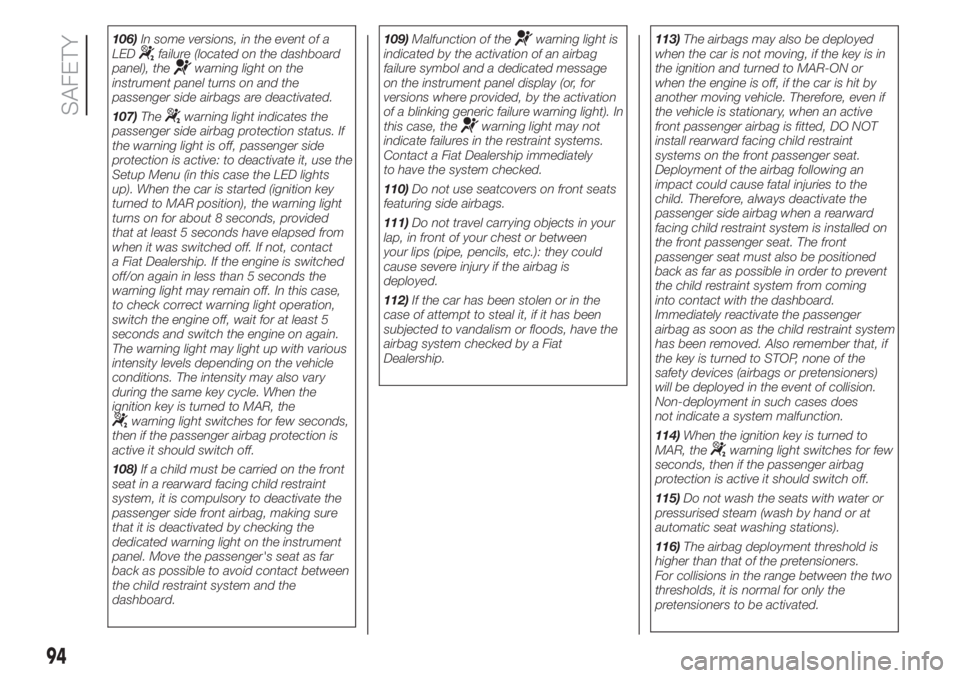
106)In some versions, in the event of a
LEDfailure (located on the dashboard
panel), thewarning light on the
instrument panel turns on and the
passenger side airbags are deactivated.
107)The
warning light indicates the
passenger side airbag protection status. If
the warning light is off, passenger side
protection is active: to deactivate it, use the
Setup Menu (in this case the LED lights
up). When the car is started (ignition key
turned to MAR position), the warning light
turns on for about 8 seconds, provided
that at least 5 seconds have elapsed from
when it was switched off. If not, contact
a Fiat Dealership. If the engine is switched
off/on again in less than 5 seconds the
warning light may remain off. In this case,
to check correct warning light operation,
switch the engine off, wait for at least 5
seconds and switch the engine on again.
The warning light may light up with various
intensity levels depending on the vehicle
conditions. The intensity may also vary
during the same key cycle. When the
ignition key is turned to MAR, the
warning light switches for few seconds,
then if the passenger airbag protection is
active it should switch off.
108)If a child must be carried on the front
seat in a rearward facing child restraint
system, it is compulsory to deactivate the
passenger side front airbag, making sure
that it is deactivated by checking the
dedicated warning light on the instrument
panel. Move the passenger's seat as far
back as possible to avoid contact between
the child restraint system and the
dashboard.109)Malfunction of the
warning light is
indicated by the activation of an airbag
failure symbol and a dedicated message
on the instrument panel display (or, for
versions where provided, by the activation
of a blinking generic failure warning light). In
this case, the
warning light may not
indicate failures in the restraint systems.
Contact a Fiat Dealership immediately
to have the system checked.
110)Do not use seatcovers on front seats
featuring side airbags.
111)Do not travel carrying objects in your
lap, in front of your chest or between
your lips (pipe, pencils, etc.): they could
cause severe injury if the airbag is
deployed.
112)If the car has been stolen or in the
case of attempt to steal it, if it has been
subjected to vandalism or floods, have the
airbag system checked by a Fiat
Dealership.113)The airbags may also be deployed
when the car is not moving, if the key is in
the ignition and turned to MAR-ON or
when the engine is off, if the car is hit by
another moving vehicle. Therefore, even if
the vehicle is stationary, when an active
front passenger airbag is fitted, DO NOT
install rearward facing child restraint
systems on the front passenger seat.
Deployment of the airbag following an
impact could cause fatal injuries to the
child. Therefore, always deactivate the
passenger side airbag when a rearward
facing child restraint system is installed on
the front passenger seat. The front
passenger seat must also be positioned
back as far as possible in order to prevent
the child restraint system from coming
into contact with the dashboard.
Immediately reactivate the passenger
airbag as soon as the child restraint system
has been removed. Also remember that, if
the key is turned to STOP, none of the
safety devices (airbags or pretensioners)
will be deployed in the event of collision.
Non-deployment in such cases does
not indicate a system malfunction.
114)When the ignition key is turned to
MAR, the
warning light switches for few
seconds, then if the passenger airbag
protection is active it should switch off.
115)Do not wash the seats with water or
pressurised steam (wash by hand or at
automatic seat washing stations).
116)The airbag deployment threshold is
higher than that of the pretensioners.
For collisions in the range between the two
thresholds, it is normal for only the
pretensioners to be activated.
94
SAFETY
Page 98 of 228
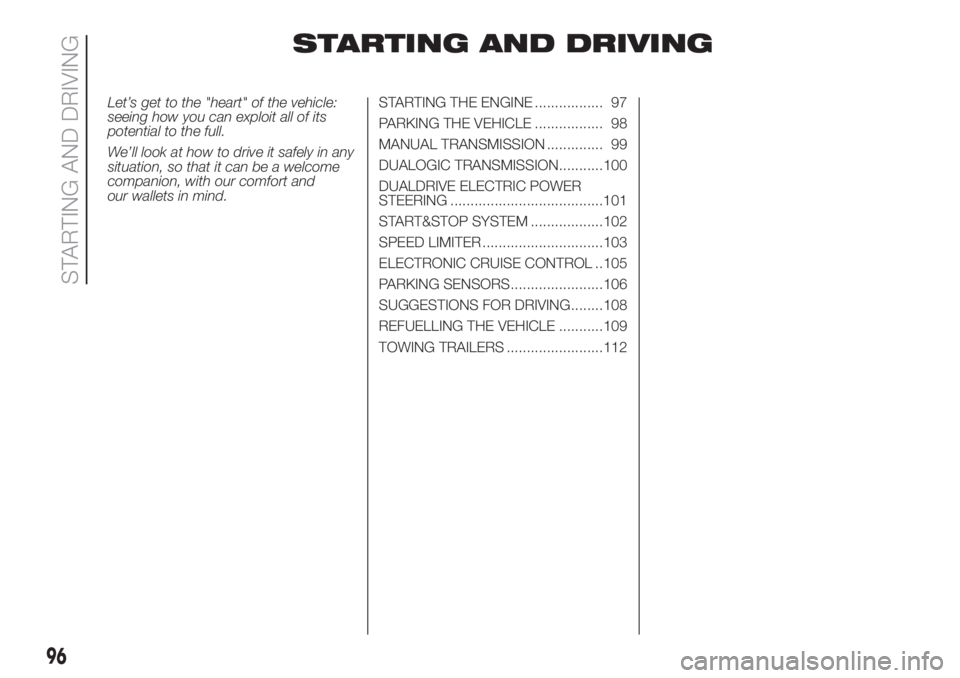
STARTING AND DRIVING
Let’s get to the "heart" of the vehicle:
seeing how you can exploit all of its
potential to the full.
We’ll look at how to drive it safely in any
situation, so that it can be a welcome
companion, with our comfort and
our wallets in mind.STARTING THE ENGINE ................. 97
PARKING THE VEHICLE ................. 98
MANUAL TRANSMISSION .............. 99
DUALOGIC TRANSMISSION...........100
DUALDRIVE ELECTRIC POWER
STEERING ......................................101
START&STOP SYSTEM ..................102
SPEED LIMITER ..............................103
ELECTRONIC CRUISE CONTROL ..105
PARKING SENSORS.......................106
SUGGESTIONS FOR DRIVING........108
REFUELLING THE VEHICLE ...........109
TOWING TRAILERS ........................112
96
STARTING AND DRIVING
Page 99 of 228
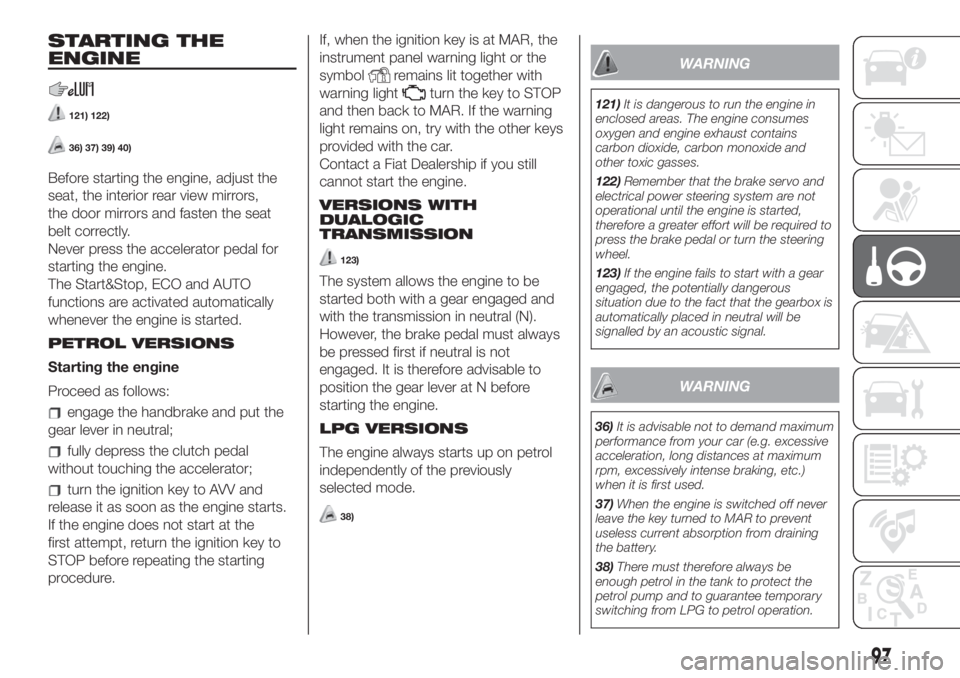
STARTING THE
ENGINE
121) 122)
36) 37) 39) 40)
Before starting the engine, adjust the
seat, the interior rear view mirrors,
the door mirrors and fasten the seat
belt correctly.
Never press the accelerator pedal for
starting the engine.
The Start&Stop, ECO and AUTO
functions are activated automatically
whenever the engine is started.
PETROL VERSIONS
Starting the engine
Proceed as follows:
engage the handbrake and put the
gear lever in neutral;
fully depress the clutch pedal
without touching the accelerator;
turn the ignition key to AVV and
release it as soon as the engine starts.
If the engine does not start at the
first attempt, return the ignition key to
STOP before repeating the starting
procedure.If, when the ignition key is at MAR, the
instrument panel warning light or the
symbol
remains lit together with
warning light
turn the key to STOP
and then back to MAR. If the warning
light remains on, try with the other keys
provided with the car.
Contact a Fiat Dealership if you still
cannot start the engine.
VERSIONS WITH
DUALOGIC
TRANSMISSION
123)
The system allows the engine to be
started both with a gear engaged and
with the transmission in neutral (N).
However, the brake pedal must always
be pressed first if neutral is not
engaged. It is therefore advisable to
position the gear lever at N before
starting the engine.
LPG VERSIONS
The engine always starts up on petrol
independently of the previously
selected mode.
38)
WARNING
121)It is dangerous to run the engine in
enclosed areas. The engine consumes
oxygen and engine exhaust contains
carbon dioxide, carbon monoxide and
other toxic gasses.
122)Remember that the brake servo and
electrical power steering system are not
operational until the engine is started,
therefore a greater effort will be required to
press the brake pedal or turn the steering
wheel.
123)If the engine fails to start with a gear
engaged, the potentially dangerous
situation due to the fact that the gearbox is
automatically placed in neutral will be
signalled by an acoustic signal.
WARNING
36)It is advisable not to demand maximum
performance from your car (e.g. excessive
acceleration, long distances at maximum
rpm, excessively intense braking, etc.)
when it is first used.
37)When the engine is switched off never
leave the key turned to MAR to prevent
useless current absorption from draining
the battery.
38)There must therefore always be
enough petrol in the tank to protect the
petrol pump and to guarantee temporary
switching from LPG to petrol operation.
97
Page 100 of 228

39)Never, under any circumstances, jump
start the engine by pushing, towing or
coasting downhill. This could cause fuel to
flow into the catalytic converter and
damage it beyond repair.
40)A quick burst on the accelerator before
stopping the engine serves no practical
purpose; it wastes fuel and is especially
damaging to turbocharged engines.PARKING THE
VEHICLE
When parking and leaving the car,
proceed as follows:
engage a gear (1stgear if facing
uphill or reverse if facing downhill) and
leave the wheels turned;
stop the engine and engage the
handbrake;
always remove the ignition key.
Block the wheels with a wedge or a
stone if the car is parked on a steep
slope.
Do not leave the ignition key on MAR to
avoid draining the battery. Always
remove the key when you leave the car.
Versions with Dualogic
transmission
To park safely it is essential to engage
1
stgear or reverse (R), with your foot on
the brake pedal and, if there is a
gradient, to operate the handbrake.
Before releasing the brake pedal, wait
until P appears on the display.
IMPORTANT NEVER leave the car with
the gearbox in neutral (or, on versions
equipped with automatic transmission,
before placing the gear lever at P).HANDBRAKE
124) 125) 126)
The handbrake lever fig. 74 is located
between the two front seats.
Handbrake engagement
To use the handbrake pull the lever
upwards until the car cannot be moved.
When the handbrake is on and the
ignition key is at MAR position, the
warning light
will appear on the
instrument panel.
Handbrake disengagement
Proceed as follows to release the
handbrake:
slightly lift the handbrake and press
release button A fig. 74;
press and hold button A and lower
the lever. The
warning light in the
instrument panel will go out.
74F0S0048
98
STARTING AND DRIVING
Page 101 of 228
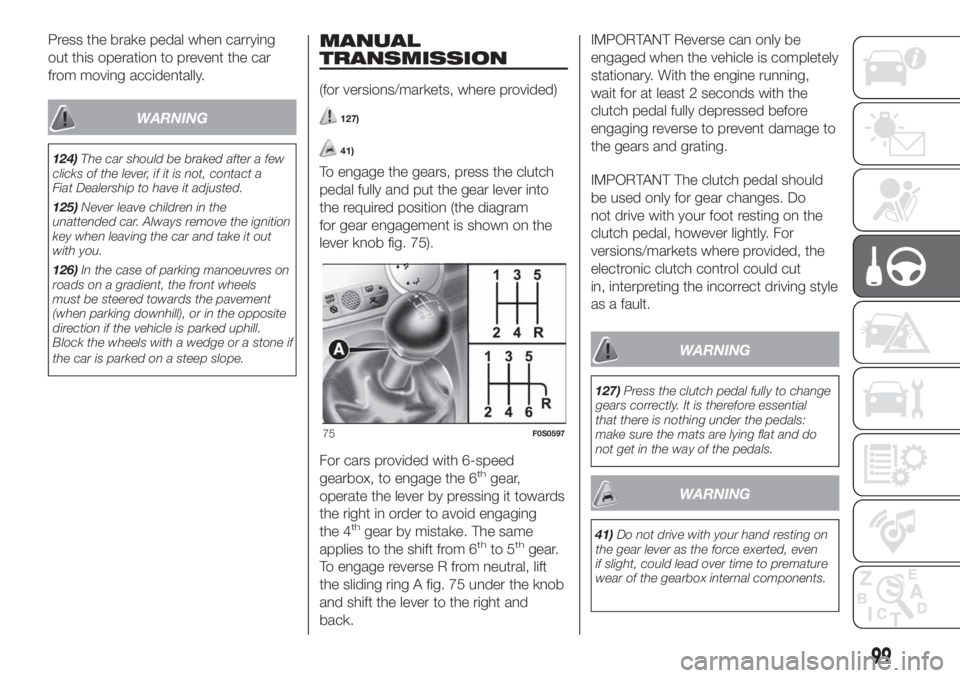
Press the brake pedal when carrying
out this operation to prevent the car
from moving accidentally.
WARNING
124)The car should be braked after a few
clicks of the lever, if it is not, contact a
Fiat Dealership to have it adjusted.
125)Never leave children in the
unattended car. Always remove the ignition
key when leaving the car and take it out
with you.
126)In the case of parking manoeuvres on
roads on a gradient, the front wheels
must be steered towards the pavement
(when parking downhill), or in the opposite
direction if the vehicle is parked uphill.
Block the wheels with a wedge or a stone if
the car is parked on a steep slope.
MANUAL
TRANSMISSION
(for versions/markets, where provided)
127)
41)
To engage the gears, press the clutch
pedal fully and put the gear lever into
the required position (the diagram
for gear engagement is shown on the
lever knob fig. 75).
For cars provided with 6-speed
gearbox, to engage the 6
thgear,
operate the lever by pressing it towards
the right in order to avoid engaging
the 4
thgear by mistake. The same
applies to the shift from 6thto 5thgear.
To engage reverse R from neutral, lift
the sliding ring A fig. 75 under the knob
and shift the lever to the right and
back.IMPORTANT Reverse can only be
engaged when the vehicle is completely
stationary. With the engine running,
wait for at least 2 seconds with the
clutch pedal fully depressed before
engaging reverse to prevent damage to
the gears and grating.
IMPORTANT The clutch pedal should
be used only for gear changes. Do
not drive with your foot resting on the
clutch pedal, however lightly. For
versions/markets where provided, the
electronic clutch control could cut
in, interpreting the incorrect driving style
as a fault.
WARNING
127)Press the clutch pedal fully to change
gears correctly. It is therefore essential
that there is nothing under the pedals:
make sure the mats are lying flat and do
not get in the way of the pedals.
WARNING
41)Do not drive with your hand resting on
the gear lever as the force exerted, even
if slight, could lead over time to premature
wear of the gearbox internal components.
75F0S0597
99
Page 102 of 228
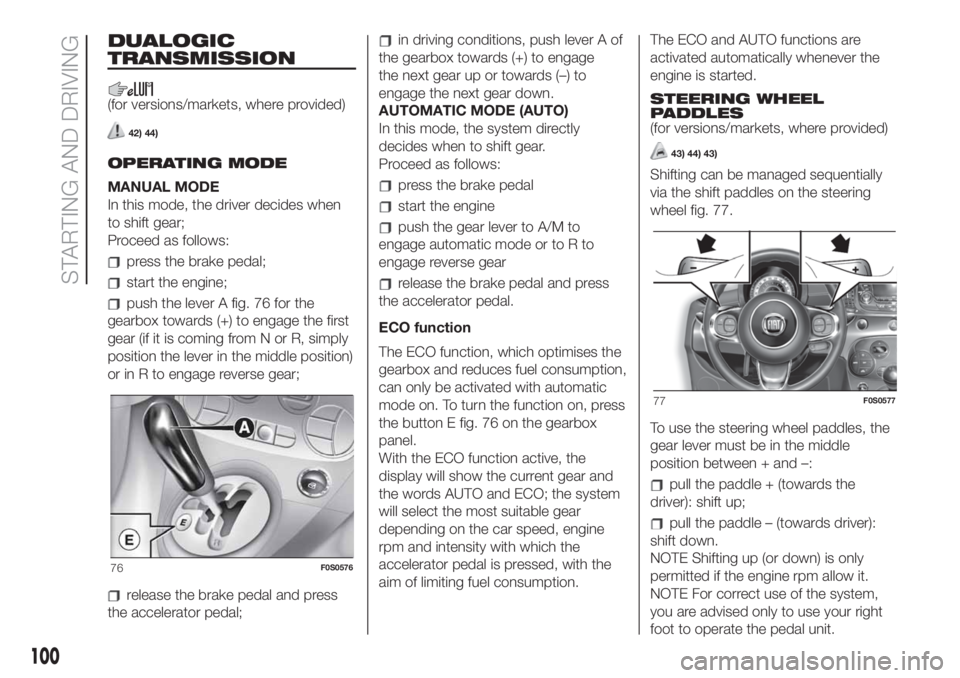
DUALOGIC
TRANSMISSION
(for versions/markets, where provided)
42) 44)
OPERATING MODE
MANUAL MODE
In this mode, the driver decides when
to shift gear;
Proceed as follows:
press the brake pedal;
start the engine;
push the lever A fig. 76 for the
gearbox towards (+) to engage the first
gear (if it is coming from N or R, simply
position the lever in the middle position)
or in R to engage reverse gear;
release the brake pedal and press
the accelerator pedal;
in driving conditions, push lever A of
the gearbox towards (+) to engage
the next gear up or towards (–) to
engage the next gear down.
AUTOMATIC MODE (AUTO)
In this mode, the system directly
decides when to shift gear.
Proceed as follows:
press the brake pedal
start the engine
push the gear lever to A/M to
engage automatic mode or to R to
engage reverse gear
release the brake pedal and press
the accelerator pedal.
ECO function
The ECO function, which optimises the
gearbox and reduces fuel consumption,
can only be activated with automatic
mode on. To turn the function on, press
the button E fig. 76 on the gearbox
panel.
With the ECO function active, the
display will show the current gear and
the words AUTO and ECO; the system
will select the most suitable gear
depending on the car speed, engine
rpm and intensity with which the
accelerator pedal is pressed, with the
aim of limiting fuel consumption.The ECO and AUTO functions are
activated automatically whenever the
engine is started.
STEERING WHEEL
PADDLES
(for versions/markets, where provided)
43) 44) 43)
Shifting can be managed sequentially
via the shift paddles on the steering
wheel fig. 77.
To use the steering wheel paddles, the
gear lever must be in the middle
position between + and –:
pull the paddle + (towards the
driver): shift up;
pull the paddle – (towards driver):
shift down.
NOTE Shifting up (or down) is only
permitted if the engine rpm allow it.
NOTE For correct use of the system,
you are advised only to use your right
foot to operate the pedal unit.
76F0S0576
77F0S0577
100
STARTING AND DRIVING
Page 103 of 228
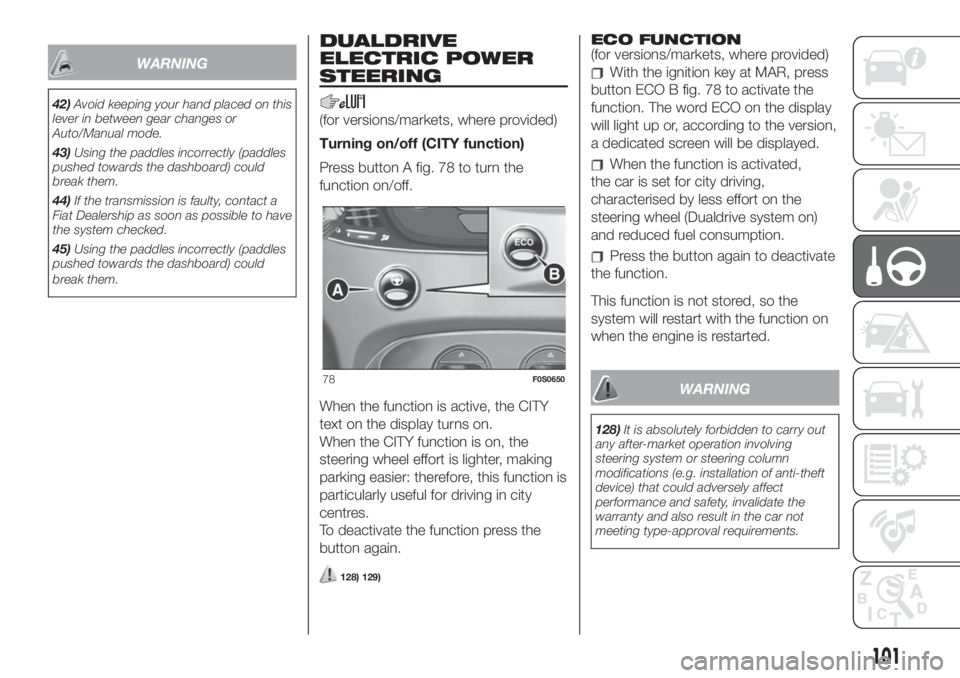
WARNING
42)Avoid keeping your hand placed on this
lever in between gear changes or
Auto/Manual mode.
43)Using the paddles incorrectly (paddles
pushed towards the dashboard) could
break them.
44)If the transmission is faulty, contact a
Fiat Dealership as soon as possible to have
the system checked.
45)Using the paddles incorrectly (paddles
pushed towards the dashboard) could
break them.
DUALDRIVE
ELECTRIC POWER
STEERING
(for versions/markets, where provided)
Turning on/off (CITY function)
Press button A fig. 78 to turn the
function on/off.
When the function is active, the CITY
text on the display turns on.
When the CITY function is on, the
steering wheel effort is lighter, making
parking easier: therefore, this function is
particularly useful for driving in city
centres.
To deactivate the function press the
button again.
128) 129)
ECO FUNCTION
(for versions/markets, where provided)
With the ignition key at MAR, press
button ECO B fig. 78 to activate the
function. The word ECO on the display
will light up or, according to the version,
a dedicated screen will be displayed.
When the function is activated,
the car is set for city driving,
characterised by less effort on the
steering wheel (Dualdrive system on)
and reduced fuel consumption.
Press the button again to deactivate
the function.
This function is not stored, so the
system will restart with the function on
when the engine is restarted.
WARNING
128)It is absolutely forbidden to carry out
any after-market operation involving
steering system or steering column
modifications (e.g. installation of anti-theft
device) that could adversely affect
performance and safety, invalidate the
warranty and also result in the car not
meeting type-approval requirements.
78F0S0650
101
Page 104 of 228
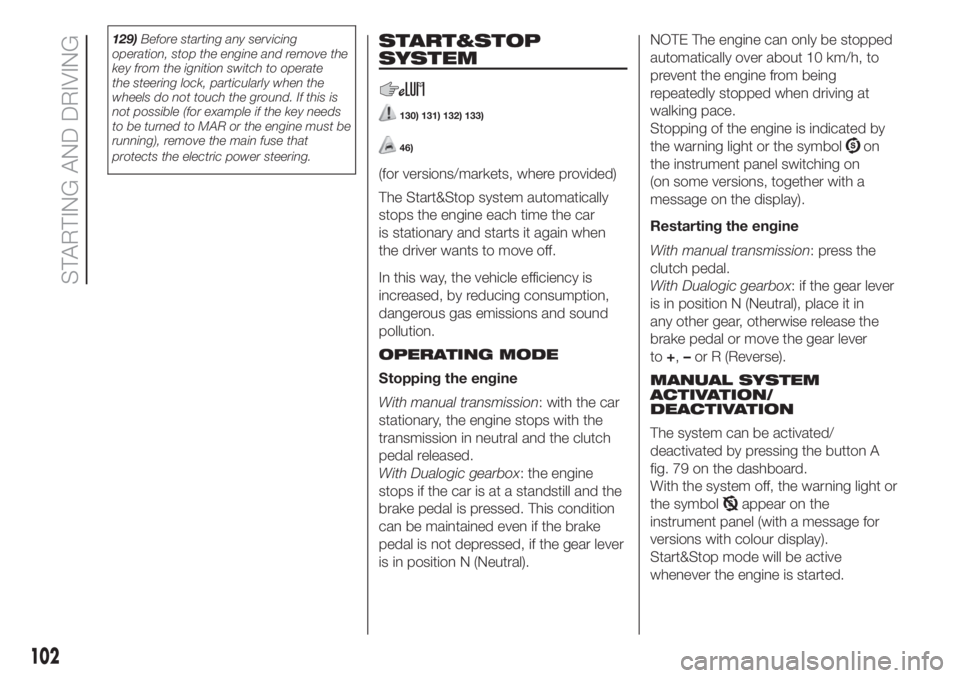
129)Before starting any servicing
operation, stop the engine and remove the
key from the ignition switch to operate
the steering lock, particularly when the
wheels do not touch the ground. If this is
not possible (for example if the key needs
to be turned to MAR or the engine must be
running), remove the main fuse that
protects the electric power steering.START&STOP
SYSTEM
130) 131) 132) 133)
46)
(for versions/markets, where provided)
The Start&Stop system automatically
stops the engine each time the car
is stationary and starts it again when
the driver wants to move off.
In this way, the vehicle efficiency is
increased, by reducing consumption,
dangerous gas emissions and sound
pollution.
OPERATING MODE
Stopping the engine
With manual transmission: with the car
stationary, the engine stops with the
transmission in neutral and the clutch
pedal released.
With Dualogic gearbox: the engine
stops if the car is at a standstill and the
brake pedal is pressed. This condition
can be maintained even if the brake
pedal is not depressed, if the gear lever
is in position N (Neutral).NOTE The engine can only be stopped
automatically over about 10 km/h, to
prevent the engine from being
repeatedly stopped when driving at
walking pace.
Stopping of the engine is indicated by
the warning light or the symbol
on
the instrument panel switching on
(on some versions, together with a
message on the display).
Restarting the engine
With manual transmission: press the
clutch pedal.
With Dualogic gearbox: if the gear lever
is in position N (Neutral), place it in
any other gear, otherwise release the
brake pedal or move the gear lever
to+,–or R (Reverse).
MANUAL SYSTEM
ACTIVATION/
DEACTIVATION
The system can be activated/
deactivated by pressing the button A
fig. 79 on the dashboard.
With the system off, the warning light or
the symbol
appear on the
instrument panel (with a message for
versions with colour display).
Start&Stop mode will be active
whenever the engine is started.
102
STARTING AND DRIVING